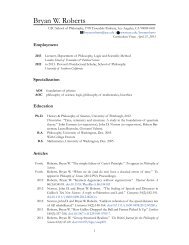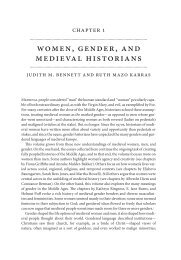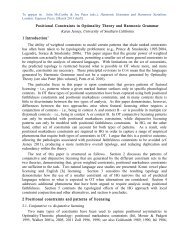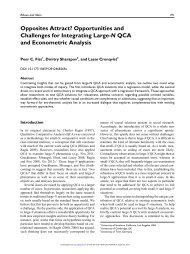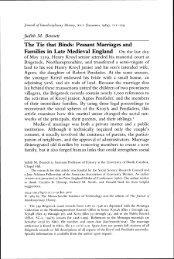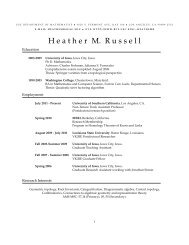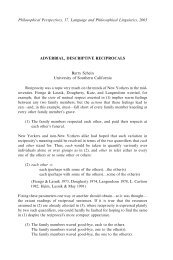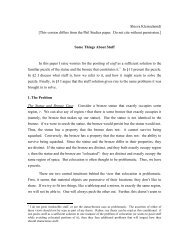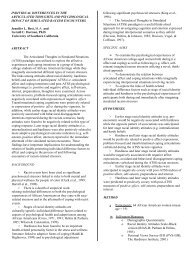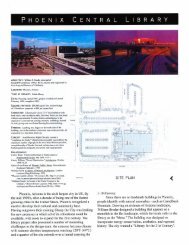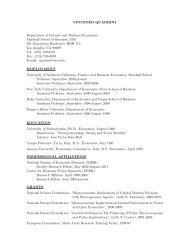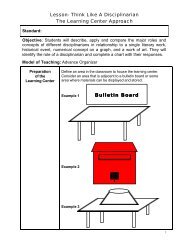Donal Crilly (LBS) -- An Introduction to Fuzzy Set QCA - Usc
Donal Crilly (LBS) -- An Introduction to Fuzzy Set QCA - Usc
Donal Crilly (LBS) -- An Introduction to Fuzzy Set QCA - Usc
You also want an ePaper? Increase the reach of your titles
YUMPU automatically turns print PDFs into web optimized ePapers that Google loves.
<strong>Introduction</strong> <strong>to</strong> <strong>Fuzzy</strong>-<strong>Set</strong><br />
<strong>An</strong>alysis<br />
<strong>Donal</strong> <strong>Crilly</strong><br />
London Business School<br />
Presentation for <strong>QCA</strong> PDW, Orlando, 2013
Source: Marx et al. (2012)<br />
Rapid increase<br />
in number of<br />
articles using<br />
fuzzy set<br />
analysis (fs<strong>QCA</strong>)
Not all Democracies 1 are Equal.<br />
1<br />
Or most other things social scientists care about
Why <strong>Fuzzy</strong> <strong>Set</strong>s (fs<strong>QCA</strong>)?<br />
Social phenomena differ in kind and degree<br />
• Difference in kind: democracy versus<br />
authoritarian regime<br />
• Difference in degree: Norway vs. Italy (equally<br />
democratic?)<br />
fs<strong>QCA</strong> combines set-theoretic analysis with<br />
gradations in set membership<br />
• Crisp sets (0 or 1): differences in kind<br />
• <strong>Fuzzy</strong> sets (between 0 and 1): differences in kind and<br />
degree
Calibration<br />
Membership has <strong>to</strong> be “purposefully calibrated”<br />
(Ragin, 2008: 30)<br />
Calibration =/= measurement
Source: Economist Intelligence Unit Democracy Index, 2010<br />
Norway outscores its neighbors on most dimensions, but these indica<strong>to</strong>rs don’t tell us<br />
whether Norway is democratic.<br />
Is the UK (score 8.16) a democracy or a dicta<strong>to</strong>rship?
• Cannot consider a country a democracy simply<br />
because its score is above the sample mean<br />
• Ultimately, must depend on some qualitative<br />
assessment of what warrants being<br />
considered a democracy
Measurement vs. Calibration<br />
Measurement<br />
• Aims for fine gradations between<br />
cases<br />
• Shows relative positions of cases<br />
• All variation treated as important<br />
Calibration<br />
• Aims <strong>to</strong> make position of a case<br />
interpretable<br />
• Considers how well cases meet<br />
requirements for inclusion in a<br />
category<br />
• Not all variation treated as<br />
important
Calibration Approaches<br />
Crisp set<br />
Three-value<br />
fuzzy set<br />
Four-value<br />
fuzzy set<br />
Six-value fuzzy<br />
set<br />
“Continuous”<br />
fuzzy set<br />
1 = fully in<br />
1 = fully in<br />
1 = fully in<br />
1 = fully out<br />
1 = fully in<br />
0.5 = neither<br />
fully in nor fully<br />
out<br />
0.67 = more in<br />
than out<br />
0.33 = more in<br />
than out<br />
0.8 = mostly<br />
(not fully) in<br />
0.6 = more or<br />
less in<br />
0.4 = more or<br />
less out<br />
0.2 = mostly<br />
(not fully) out<br />
More in than<br />
out<br />
0.5 = cross<br />
over: neither in<br />
nor out<br />
More out than<br />
in<br />
0 = fully out<br />
0 = fully out<br />
0 = fully out<br />
0 = fully out<br />
0 = fully out<br />
Based on Ragin (2008)
Calibration: Examples<br />
• Identify distinct qualitative groupings based on<br />
substantive knowledge<br />
• Not simply ordinal scales!<br />
• Use external standards wherever possible<br />
• For example, democracy classification (EIU)<br />
• Full democracies (1),<br />
• Flawed democracies (0.66),<br />
• Hybrid regimes (0.33), and<br />
• Authoritarian regimes (0)<br />
• Country development (based on UNDP HDI cf. <strong>Crilly</strong>,<br />
2011)<br />
• Very high (1),<br />
• high( (0.66),<br />
• Medium (0.33), and<br />
• Low (0)
Democracy Index
Continuous <strong>Fuzzy</strong> <strong>Set</strong>: Direct<br />
Calibration Method<br />
• Used <strong>to</strong> transform interval-scale variables in<strong>to</strong><br />
membership scores between 0 and 1<br />
• Three ‘qualitative’ anchors<br />
1. Threshold for full membership<br />
2. Threshold for full non-membership<br />
3. Cross-over point (maximum ambiguity)<br />
E.g. Firm size based on European Union enterprise size<br />
classes (Fiss, 2011)<br />
1. Full membership: 250 + employees<br />
2. Full non-membership: < 10 employees<br />
3. Cross-over point: 50 employees<br />
• This calibration can be performed using fs<strong>QCA</strong> software
EMPIRICAL EXAMPLE
Faking it or Muddling Through? Decoupling in<br />
Response <strong>to</strong> Stakeholder Pressures (<strong>Crilly</strong>, Zollo &<br />
Hansen)<br />
Aim: To understand why some firms implement CSR<br />
policy consistently whereas others decouple (adopt<br />
without implementing)<br />
• Data: 359 interviews across 17 firms and their<br />
stakeholders, social performance data<br />
• Why <strong>QCA</strong>? Useful for identifying how<br />
characteristics of firms and their environments<br />
combine <strong>to</strong> shape firms’ responses<br />
• Why fs<strong>QCA</strong>? Distinction between<br />
implementation/decoupling is not binary
Steps<br />
• Calibrating set membership<br />
• Constructing truth table<br />
• Reducing number of truth table rows based on<br />
• Minimum acceptable solution frequency<br />
• Minimum acceptable consistency<br />
• Generating simplified combinations from the<br />
truth table rows<br />
• (Optional: Identifying cases that are members<br />
in each configuration)
Conditions<br />
Condition Condition Calibration<br />
Outcome Implementation 0, 0.5, 1<br />
Causal<br />
conditions<br />
Information<br />
asymmetry<br />
Stakeholder<br />
consensus<br />
Organizational<br />
interest<br />
Managerial<br />
consensus<br />
0, 0.33, 0.66, 1<br />
0, 0.5, 1<br />
0, 0.33, 0,66, 1<br />
0, 0.5, 1
Example: Calibrating Managerial<br />
Consensus (based on measure of variance<br />
of responses)<br />
Membership Threshold Evidence from firm at threshold<br />
1 Variance below 0.30 “Agreeing what’s important can’t be<br />
decentralized. You have <strong>to</strong> do it centrally<br />
and then roll it out.”<br />
0.5 Variance 0.30 – 0.60 Consensus/dissension not a main theme<br />
0 Variance above 0.60 “All our units are very decentralized. We<br />
realize we have <strong>to</strong> be in greater harmony<br />
because the world doesn’t view us as<br />
these separate functions.”
Calibration Table<br />
Note: Cases with values of 0.5 are dropped from the fuzzy-set analysis in the<br />
fs<strong>QCA</strong> software program. Transform them by subtracting 0.001 (or adding 0.001).
Sample Truth Table
Configurations Associated with<br />
Implementation and Decoupling
Identifying Case Membership in Configurations<br />
• Assign cases <strong>to</strong> configurations on the basis of their membership of<br />
at least 0.5 in the configuration
In Closing…<br />
• fs<strong>QCA</strong> enables you <strong>to</strong> capture differences in<br />
kind and degree in the phenomena you study<br />
• Middle way between qualitative and<br />
quantitative measurement<br />
• Calibration: simultaneously quantitative and<br />
qualitative<br />
• <strong>Fuzzy</strong> sets: advantages over conventional variables
<strong>An</strong>d potential applications beyond<br />
social sciences (e.g. athlete selection<br />
for triathlon… but wait until Rio 2016)



